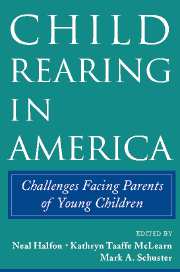Book contents
- Frontmatter
- Contents
- Tables
- Figures
- Contributors
- Acknowledgments
- 1 Introduction and Overview
- PART I CONDITIONS OF FAMILIES WITH YOUNG CHILDREN
- PART II CHILD-REARING PRACTICES
- PART III DELIVERY OF HEALTH SERVICES TO MOTHERS AND CHILDREN
- 9 Prenatal Care, Delivery, and Birth Outcomes
- 10 Access to Health Care for Young Children in the United States
- 11 Anticipatory Guidance: What Information Do Parents Receive? What Information Do They Want?
- PART IV FUTURE DIRECTIONS AND POLICY IMPLICATIONS
- Index
- References
10 - Access to Health Care for Young Children in the United States
Published online by Cambridge University Press: 15 July 2009
- Frontmatter
- Contents
- Tables
- Figures
- Contributors
- Acknowledgments
- 1 Introduction and Overview
- PART I CONDITIONS OF FAMILIES WITH YOUNG CHILDREN
- PART II CHILD-REARING PRACTICES
- PART III DELIVERY OF HEALTH SERVICES TO MOTHERS AND CHILDREN
- 9 Prenatal Care, Delivery, and Birth Outcomes
- 10 Access to Health Care for Young Children in the United States
- 11 Anticipatory Guidance: What Information Do Parents Receive? What Information Do They Want?
- PART IV FUTURE DIRECTIONS AND POLICY IMPLICATIONS
- Index
- References
Summary
The health care needs of children, and of young children in particular, reflect their underlying age-specific health needs. In general, the health and development issues of young children can be distinguished from those of older children on the basis of a number of important characteristics. These include high levels of dependency on family, passage through the developmentally critical period of early childhood, and a characteristically different set of health services needs Halfon and Hochstein (1997). Even among young children, it is useful to distinguish among stages of development, with the health needs of neonates (birth to 30 days), infants (1 month to 1 year of age), and children in the second and third years of life differing in important ways American Academy of Pediatrics (1997).
Current literature provides a useful foundation for understanding the health needs of young children and the ability of young children to get access to needed care. Yet much of the existing literature is dated or uses less than ideal age categorizations. In our analysis, which focuses specifically on children from birth to age 3, we attempt to build on previous studies by examining the role of race and ethnicity, income, and insurance status in determining access to care using new national data on access to a broad range of health and developmental services.
HEALTH AND ACCESS TO CARE AMONG AMERICAN CHILDREN
The Health Status of Children in the United States
The health status of all children in the United States today is generally better than it was a few decades ago, continuing a trend that began in the early part of the twentieth century.
- Type
- Chapter
- Information
- Child Rearing in AmericaChallenges Facing Parents with Young Children, pp. 293 - 319Publisher: Cambridge University PressPrint publication year: 2002
References
- 1
- Cited by

